Summer update from the Wildlife Wardens
As we whizz past the solstice, emerging from a soggy Spring into a splendid Summer, here’s an update from South East Devon Wildlife Warden, Sama.
If you’ve seen us out and about over the past couple of months you’ll know that this time of year is a favourite in the natural calendar: breeding bird season. We love to hear the increase of bird song and see many of our shy species, like Dartford Warbler, become more visible as they jostle for breeding territories.

Dartford Warbler.
We talk about breeding bird season a lot at our pop-ups across the Pebblebed Heaths at this time of year, most significantly because many heathland birds nest on the ground – heathland not being a habitat known for its tree cover! Ground nesting birds are more susceptible to disturbance than their tree nesting fellows - they don’t share the benefit of height to avoid us as we wander. We can unintentionally disturb birds from the nest as they incubate eggs, or as they protect their young from predators, just by being close by. Please do stick to the main paths to avoid this, and if dog walking, extend the same philosophy to your canine companion. Currently, we're focussing on asking people to keep ‘Paws on paths’ to help dog walkers remember the importance of staying on the path to avoid disturbing wildlife – you may have seen the banners displayed in car parks.
The official dates for breeding bird season here are 31 March–31 July, but some species begin preparations earlier, and if conditions are favourable some continue into August with second or third broods. At a time when so much wildlife is suffering decline, this small restraint can offer wildlife the chance to thrive on our local patch, something we would all be glad for.
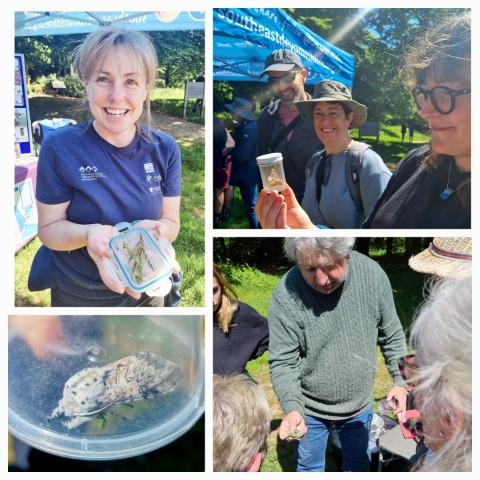
A selection of photos from our moth event.
During May, Sama was pleased to see her first Dartford Warbler fledglings of the season during the heathland Wildlife Walk she led celebrating National Nature Reserves week. Six ‘Darties’ were seen, 3 adults and 3 juveniles. ‘Darties’ are one of our key species on the Pebblebed Heaths and a true lowland heath specialist. Recovering from the brink of extinction in the UK over the last 50 years, they’re a conservation success story – there are now around 3,200 breeding pairs in the UK, and we have ~200 of these across the Pebblebed Heaths (and very proud of it we are too).
For a chance to see or hear a 'Dartie' as part of a guided walk and hear about the other free events we offer, please do follow us on social media – it’s the easiest way for us to let you know our news and share fantastic local wildlife updates!
Also in May, we celebrated National Nature Reserves Week with a Marvellous Moths event at Woodbury Castle. Wildlife Warden Sama was joined by Paul Burgess of Devon Moth Group who gave a fascinating & engaging talk, showing off some of the moths that visited the light trap the evening before at Bystock Nature Reserve. Puss moth, buff-tip and fox moth were amongst the crowd pleasing favourites, though Paul was most enchanted by a new record for the location. Fantastic!
Earlier this month, Sama was lucky enough to hear Cuckoo on Woodbury Common. Want to know more about this incredible bird? Read her article below in this edition of Shores, Heaths and Dunes.
Written by Sama Euridge.
New tech on the Heaths
Fenceless grazing using GPS collars is proving to be revolutionary for conservation.
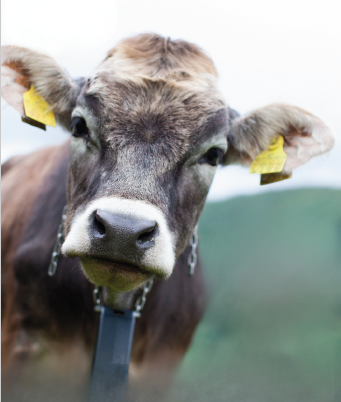
A cow wearing a GPS collar.
This technology is being embraced by those who want to mimic the grazing behaviour of wild herds, ensuring animals “mob graze” specific areas - this creates a mosaic of habitats. Another use of the GPS collars is that they allow land managers to restrict access to particular areas, such as freshwater, where they don’t want livestock to spend any time.
So how does it work you may wonder? The cattle wear a solar-powered GPS collar, which plays an audio alert that increases in frequency as the animals approach the invisible fence line. If they continue to cross a boundary, the cattle receive a shock (similar to an electric fence). Cattle then learn not to continue in the direction of the alert to avoid receiving shocks. The invisible fence line can be moved around at any moment by the land managers, controlled through an app with a cup of tea in the other hand!
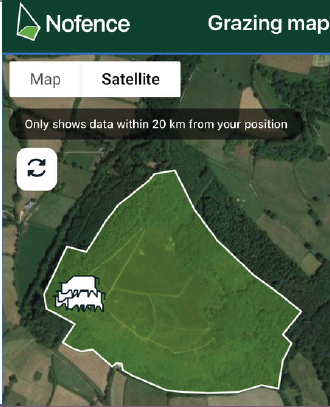
A screenshot from the NoFence App.
The RSPB in partnership with Woodland Trust and Forestry England have been trialling this technique recently on two sites: Aylesbeare Common and Fire Beacon Hill. The invisible boundaries are managed using an App called “NoFence”. You can scan this QR code to see where the livestock are now, in fact!

There are so many benefits to this new technology: it is great for biodiversity, requires less manual labour and is great value for money considering the savings on new fences, however, there are some downsides too. Without visible fences, it is difficult for dog walkers to know where cattle are. On the Pebblebed Heaths, the land managers try their best to inform users with signage, websites, newsletters and social media. Unfortunately, there has been an increase in livestock worrying recently, so it is crucial to remind dog owners to keep dogs under close control/ on lead if necessary. Thanks for working with us to prevent livestock from crossing into dangerous areas outside these new invisible boundaries!
Written by Imo Salmon.
Cuckoos in decline
Cuckoo is a brief visitor to our sunny shores, the males arriving in the latter weeks of April and leaving again as early as the first week of June - which is why I was so surprised and delighted to hear one at Woodbury Castle a couple of weeks ago.
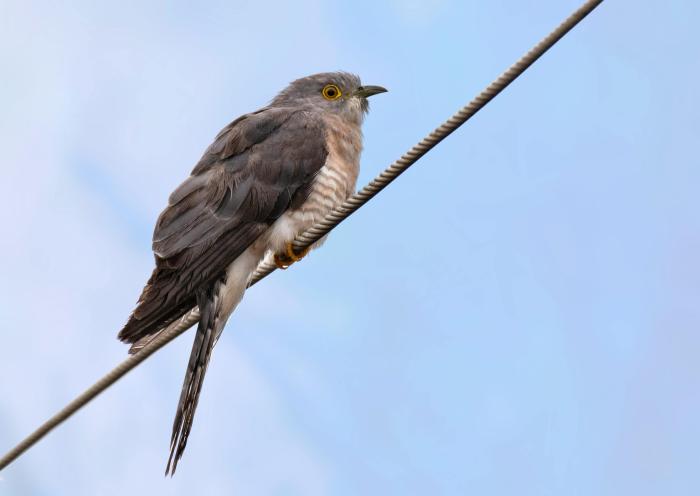
A Cuckoo on a wire.
Moments earlier, I had been lamenting the lack of cuckoo call and indeed meadow pipit (one of the species they parasitize) across the Pebblebed Heaths this year – and then out of nowhere, there it was: cuckoo, cuckoo! The sound was so clear and unexpected, that in our elation we joked perhaps we would round a corner to find that it was in fact, just someone’s ring tone. It was an instantly disappointing comparison. How sad that we listen for our phones more now than for bird song.
Hearing cuckoo call incites a bittersweet elation in me. It’s a joyful herald of spring in the countryside, but the fact that it’s now an ‘event’, infrequent rather than common place, is profound. Cuckoo numbers are declining in Britain and the bird's familiar two-tone call has been lost form many of its former haunts. These intriguing mimics are now Red listed on the UK Birds of Conservation Concern.
Cuckoo, cuckoo, what do you do?
Interestingly, the decline seems to be regionally specific - while we have lamentably lost two-thirds of English cuckoos in the last 30 years, Scottish and Welsh cuckoos thankfully have not shared this fate. The brilliant Cuckoo Tracking Project was set up by the BTO to investigate (definitely worth checking out if you have any interest in Cuckoos and migration).
Results have revealed that the dichotomy lies in the differing routes cuckoos take as they leave the UK to return to wintering grounds in the Congo. English Cuckoos have preference for a south-westerly route though Spain - by contrast Scottish and Welsh cuckoos travel south-east through Italy. Monitoring has revealed that prolonged droughts along the south-western route have resulted in increased mortality whilst on migration – English cuckoos just can’t find the food to sustain the epic effort required to achieve a Sahara transit.
In April I open my bill
In May I sing night and day
In June I change my tune
It’s actually only male cuckoos that deliver the iconic ‘cuck-oo’ call, used to advertise their presence on the breeding grounds and deter the competition. Territorial males will call repeatedly throughout the day, and it was likely this we heard while on Woodbury Common last week. A friend reported that he was still calling into the evening when she visited. Has he yet to find a mate so late in the season?
As loners that parasitize the social systems of other birds, cuckoos have less need than others for complex vocal communication, preferring instead to fly under the radar. But, as the rhyme suggests, they do have a bit more to say than just “cuckoo.”
Males also have a three-syllable version – “cuck- cuckoo” - which appears to have more to do with attracting a female – so perhaps he has already found a mate! If excited, they also make a lively ‘gowk gowk gowk’. Females themselves produce a bubbling, ‘kwik-kwik-kwik’, suspected to mimic the call of sparrowhawks – a clever tactic deployed to scare host species from their nests, so she may nip in and lay her parasitic egg.
Female cuckoos don’t lay haphazardly but target the nests of specific bird species. In the UK, this is usually reed warbler, dunnock, or meadow pipit. Which a female has preference for, or more specifically which she produces eggs to mimic, is genetically dependant. This fascinating polymorphism is an attribute that separates cuckoos into distinct races (or ‘gentes’, singular ‘gens’). Whilst still remaining the same species, each gens is behaviourally distinct and often habitat specific.
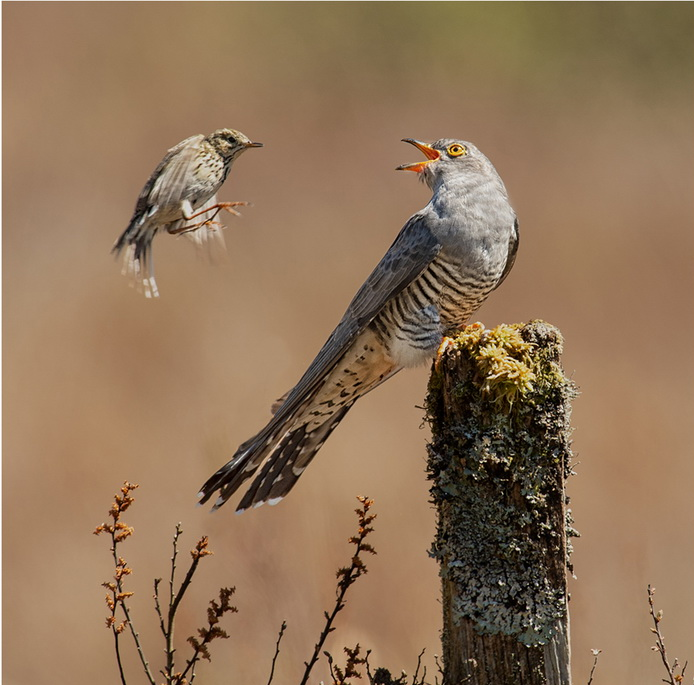
A Meadow Pipit feeding a Cuckoo (copyright Phillipa Wheatcroft)
Interestingly, research has shown that some host species are better at detecting cuckoo eggs than others. Blackcaps, which were also in song at Woodbury Castle, would otherwise make excellent foster parents, but appear to have wised up to the cuckoo’s devious devices. Acceptance levels of cuckoo eggs vary even amongst the host species. Dunnocks, seem to be especially clueless, and almost always accept a bonus egg. Oh, Dunnock.
In July I prepare to fly
In August away I must
One can only assume that the remaining months in the verse, apply to the fledging of juveniles, as the parents absent almost immediately once the deception is complete. The solitary egg is left to fend for itself as the adults depart for distant shores.
Written by Sama Euridge.
Reptile talk
So much more than its spikey exterior exudes, heathland supports a huge variety of remarkable wildlife – and for our native reptiles, it’s a vital habitat.
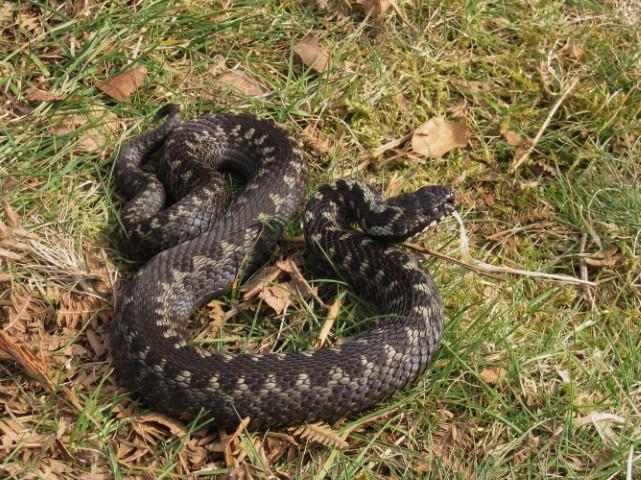
A male Adder.
As the sun shows its watery first at the beginning of the year and we all yearn for spring to bloom forth, I have my eyes peeled, hoping for a glimpse of this shy and enigmatic creature.
Although commonly seen basking on path edges in the summer months, it only needs to be around 10°C for adders to emerge in spring, with some sightings reported of them in snow! Males appear first, to dance for territory and then the attention of the later rising females.
Distinguished by a diamond zig-zag print along their backs, females are a glowing sandy copper, with males ranging from monochromatic grey and white, to occasionally completely black. A striking look in combination with their ruby-red eyes.
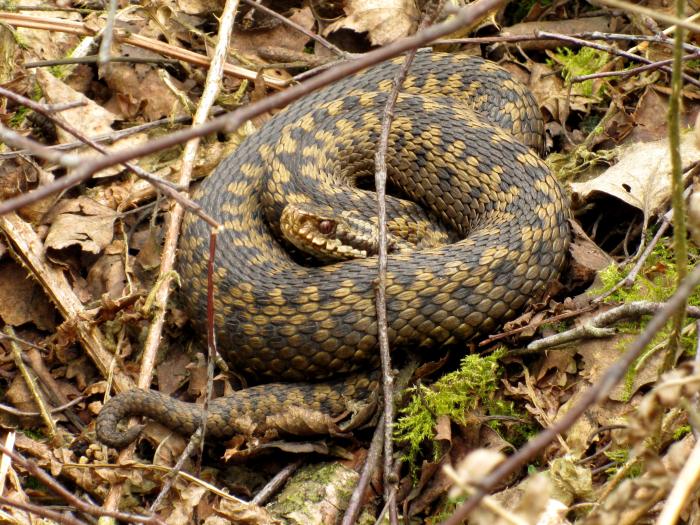
A female Adder.
Mature open heath provides exactly the right mix of warmth, cover and abundant food supply that these animals need and as a species in decline they should be celebrated on the Pebblebed Heaths, but are often regarded with fear.
When we host our information pop-up events in car parks across the heath, we are always asked about them at this time of year. Often misinformation about this shy and secretive creature is fuelled by negative media portrayal - any article with ‘dangerous’ or ‘deadly’ in the title make me sigh with frustration – yes, adders are the UKs only venomous snake, but like a misunderstood kid with a bad reputation, they are also so much more.
So let’s start by dispelling some myths and offering reassurance, because time spent in green space should be a calming experience – a place for contemplation and connection, not concern.
The chances of being bitten by an adder are exceedingly low. An adder’s venom is an evolutionary adaptation to help subdue their prey. Their main defence from predators is not to bite, but to hide. They are shy, secretive creatures of camouflage.
Even if you are unlucky enough to get bitten, adder bites to humans or dogs are rarely anything more than an annoyance. In the last 150 years, there have been only 14 recorded human deaths from adder bite, the last being in 1975. In about 70% of cases, there is a negligible reaction or only local effects – which can be unpleasant, but are easily treated. In a British study of dogs bitten by adders, under 5% of adder bites led to mortality. Thank goodness.
Almost all bites occur when the snake is surprised by disturbance. An easy way to prevent this is to keep yourself and your dog on well-used paths and out of the heather. This will greatly reduce the risk of accidental interactions, and also has the benefit of not disturbing ground-nesting birds. I want to say, two birds, one stone, but perhaps that’s not the best analogy?
Adders feed predominantly on lizards and small mammals and rest underground in the colder months, in disused burrows or coiled amongst twisting roots. They grow to 60–90cm and can live for up to 10 years. Females only breed once every two or three years, with mating taking place around April or May. They incubate their eggs internally, rather than laying shelled eggs (which the grass snake does) and give birth to around up to 20 live young in August or September. Amazing!
Sadly, adders have been given a bad reputation over the years, leading to persecution in many areas. According to recent research, many populations of adders are at risk of local extinction, and could disappear from unprotected sites in as little as a decade. We only have 3 native snake species here in the UK, what a tragedy it would be to lose a creature that has had such a historical and cultural significance across our countryside.
Brilliant adder advice can always be found on the ARC Trust website a lovely resource for all things amphibian and reptile. Read how to treat adder bites.
Watch a pair of male adders battle for a female, filmed in South Devon by John Walters.
Here's a few fun facts about the UK's two other native snakes:
Smooth snake Our rarest terrestrial reptile, compared to the grass snake and adder, this snake is mysterious. Small, slow, secretive and scarce, it likes to hide in dense clumps of heather. Similar in appearance to adder, but slighter and with a rounder head. Nor is its best distinguishing feature smoothness, but rather a dark smudge on top of the head. Its scales are smooth though, when compared to those of adder and grass snake, which have a keel down the centre of each scale. When you next find a skin that’s been shed, check.
In summer, this snake divides its time between basking and hunting lizards, which impressively, it kills by squeezing, like a tiny boa constrictor. For reference, smooth snakes only reach 60-70cm, whereas boa constrictors can reach 13 feet. No confusing those two. Smooth snakes emerge from hibernation slightly later than grass snakes, first being seen in mid-April to early May. Mating takes place shortly after. Smooth snakes are ovoviviparous, which means that they incubate their eggs internally and give birth to live young. The young that look like miniature versions of the adults are born in September, clutch sizes typically range between 4 and 15 young.
Grass snakes are our only egg laying snake. Females lay 10-40 eggs in rotting vegetation such as compost heaps. Here they will be incubated until hatching in early Autumn. Like all reptiles, grass snakes hibernate for the winter months.
Grass snakes are also our largest snake, usually growing over 1m and up to 1.5m. They are greyish green in colour with a pale belly and dark markings on their sides. As keen swimmers they are usually found in wetland habitats, feasting on amphibians, fish, small mammals and birds.
Written by Sama Euridge and Imo Salmon.
A seasonal update from RSPB Aylesbeare
Hello all, I hope the wet start to summer is not causing too much dismay. As of mid-June, the weather still seems to be shaking itself out of winter. It will surely seem retrospectively refreshing in a few months when we are all caught up in the British pastime of complaining about the heat.
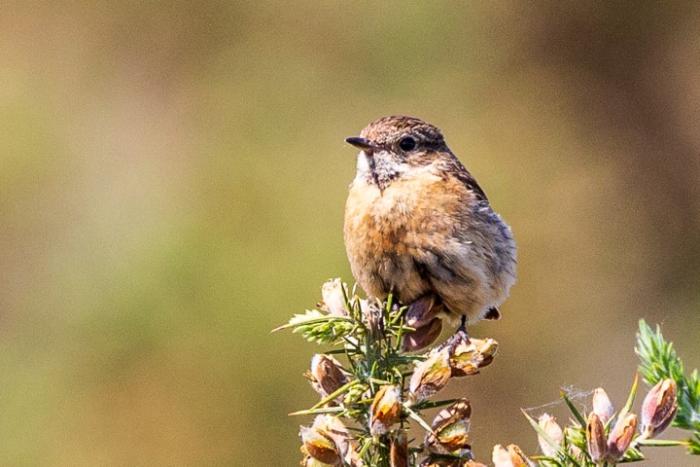
A young Stonechat.
We have been lucky during our recent surveys to observe some wonderful birds and reptiles. Some familiar faces. We have seen Dartford Warblers scratching out their jagged tunes, Linnets cheerily chirping overhead, Yellowhammers belting out their iconic sweet rising notes and Stonechats clinking a pebble to summer.
We have also been greeted by some interesting birds on passage such as a male Wheatear standing proud on the gorse and a wood warbler singing his song which recalls a spinning coin. Reed bunting have also been seen and heard at our ponds in the middle of Aylesbeare common. Years ago they were a familiar sight and here’s hoping they were the vanguard for a new generation.
All these birds can be heard during the day, but to tide us over until dawn, the nightjars are churring the evenings away. We have also come across 2 thirds of our native reptiles. Grass snakes, common lizards, slow worms and adder have all been spotted; but smooth snakes are also doing well.
The presence of all these beautiful birds competing through music to raise a clutch of strong songsters is wonderfully complemented by the adders in the heather hereabouts. This reminds us though, that it really is very helpful to ensure that when you enjoy the commons with your four-legged friends, it’s best to keep them on a lead. This is not just to prevent birds abandoning nests in fear (or not creating a nest at all), but to avoid any encounters with snakes. As somebody who was recently hissed at, even though I was looking at the ground, I can safely say they are not obvious until very close, especially the brown females.
In terms of work, it’s been a busy start to June. We have been actively fencing. The fence around manor common is up and running thanks to the dedication of Gary and our hard-working mid-week volunteers. We are repairing the posts and rail around the main gate into Venn Ottery Common, which had rotted and risked falling over. Other tasks included moving our ponies off for their holidays in the lovely Blackdown hills (lucky guys). Over the summer from late June Aylesbeare and Harpford commons will be grazed by cattle, putting in the relief shift and helping to graze the common more effectively.
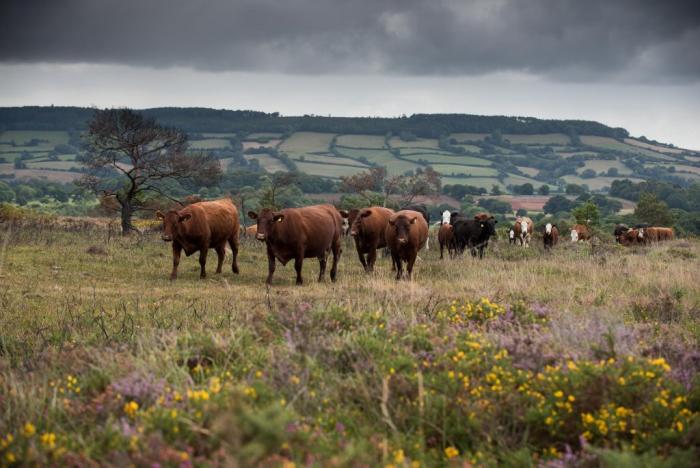
Cattle on the heaths.
Lastly, we are finalising our plans for Heath week! The last week of July will be devoted to public engagements events that take place across the Pebblebed. Events will be run by ourselves, as well as Devon Wildlife Trust and the Pebblebed Heaths Conservation Trust.
As for the RSPB, we will be running our popular Bats, Moths and Nightjars evening. It is an amazing opportunity to anybody wishing to see which creatures stir when we are we are asleep and a reminder that nature is ceaseless in its activity, filling every bit in time with productivity.
Other events including pond dipping, which is excellent for kids and adults who retain their sense of wonder, and a new “Heath Hunt.” This curated walk will allow people to compete to find and identify our various heathland flora and fauna while learning the history and ecological importance of our heaths. If you are not the competitive sort, then feel free to use our beautiful print outs to start off on a wildlife ID quest. Trust me, when you start identifying wildlife it makes every trip outside the house so much richer.
Written by RSPB residential volunteer Tom Whyte.